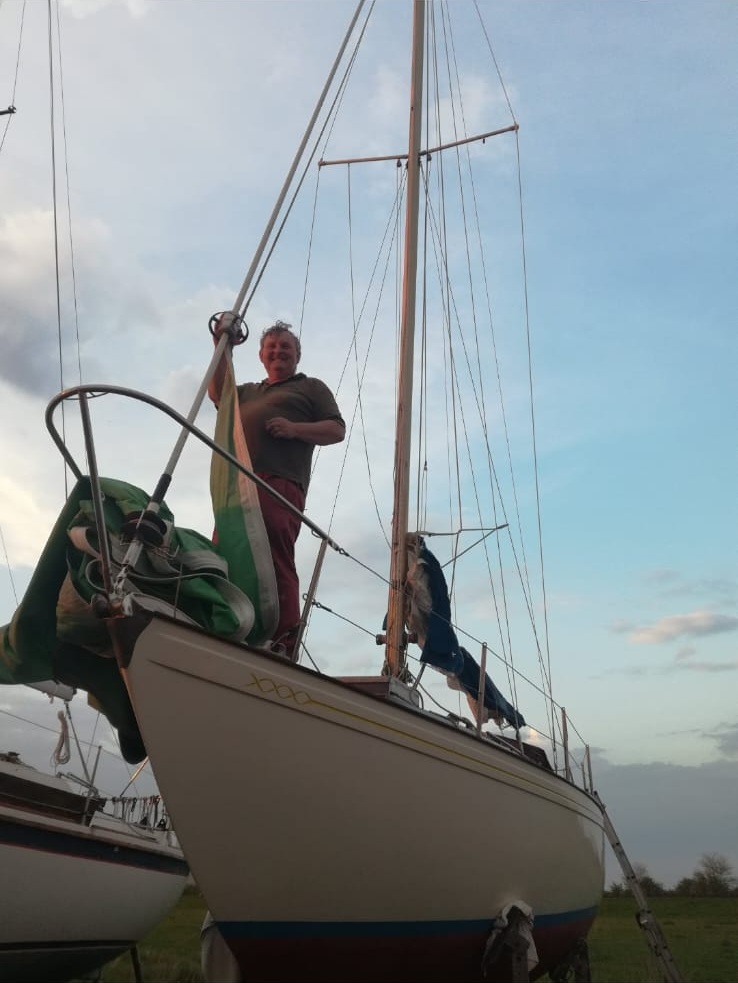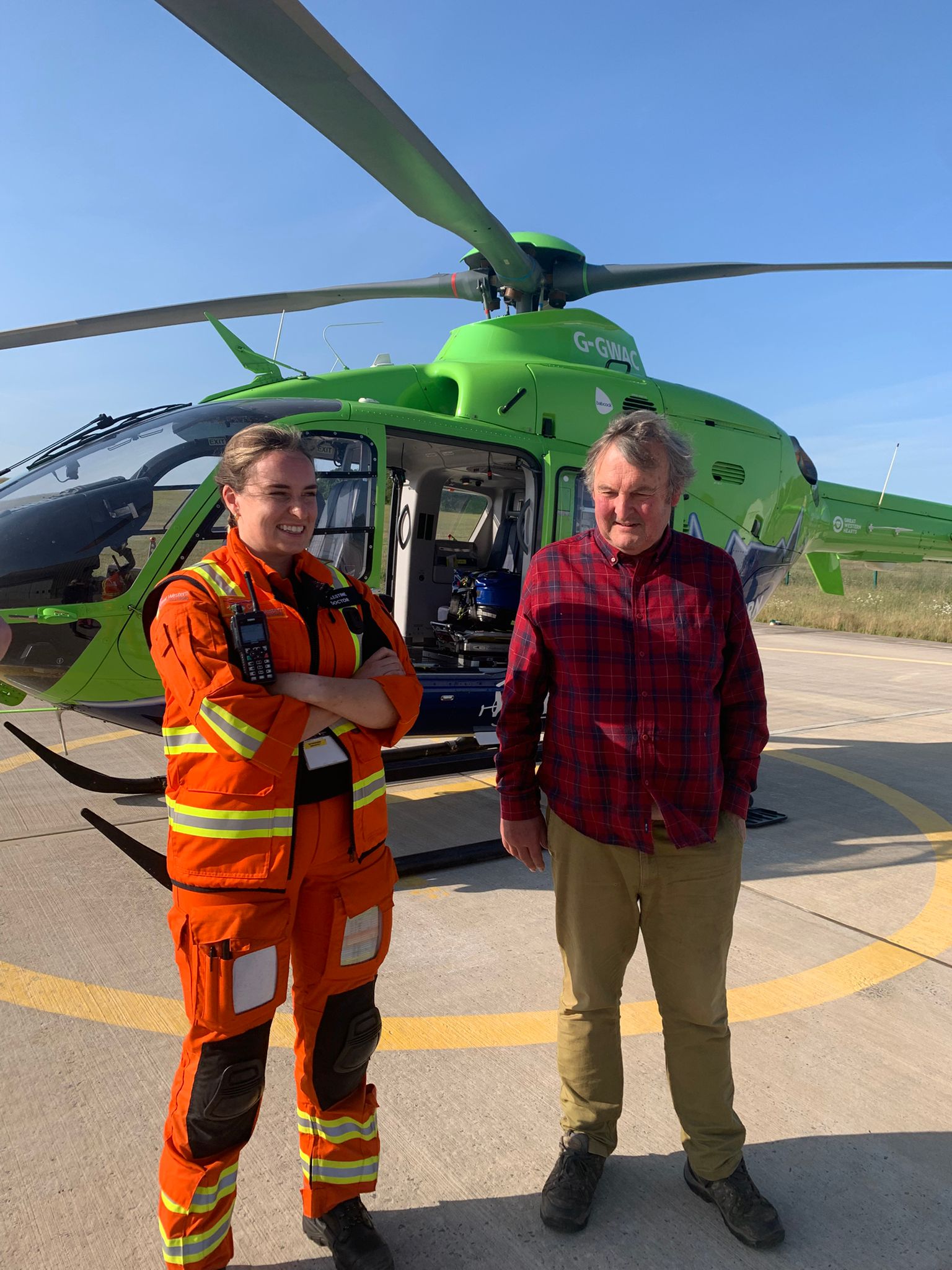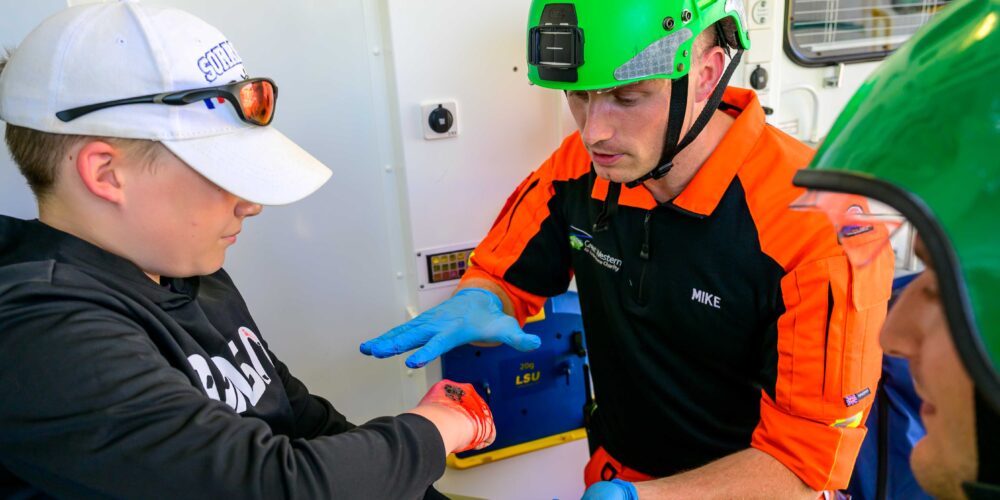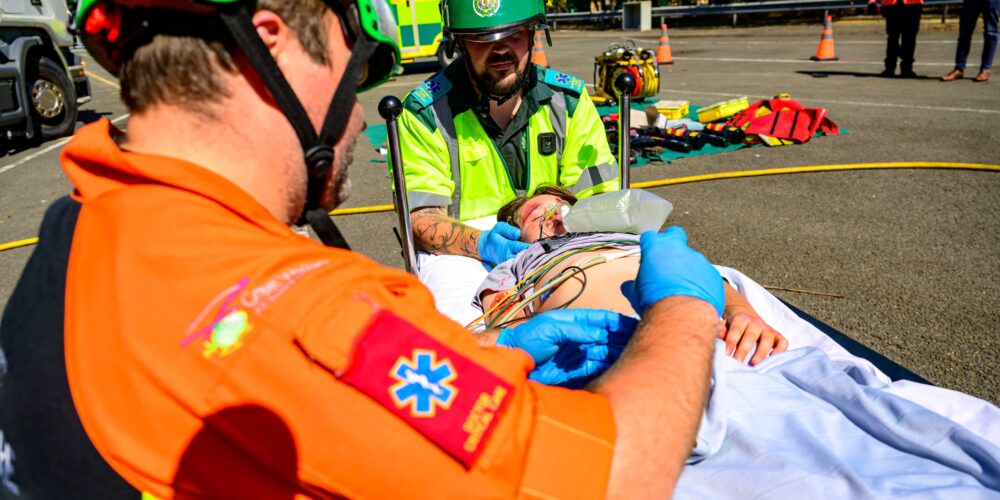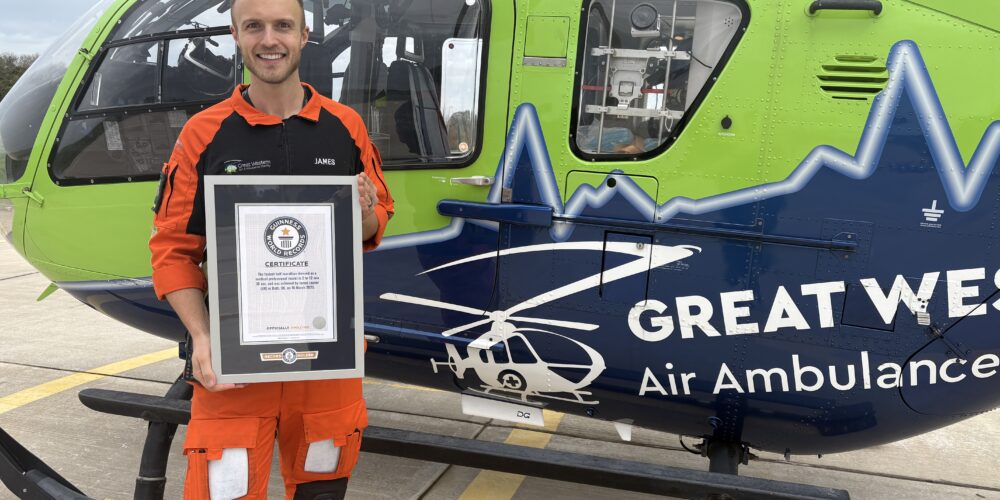
Renowned Gloucestershire artist PJ Crook raises funds for GWAAC
July 18, 2025
Swimming lengths for GWAAC
August 4, 2025On 12 April 2025 Archaeologist Mark Horton, best known for presenting BBC’s Coast for 11 years, was carrying out routine maintenance on a yacht at Lydney Harbour when things took an unexpected turn. He found himself in need of Great Western Air Ambulance Charity (GWAAC).
The yacht was moored against the harbour wall and Mark was on board waiting for the tide to go out so he could clean the bottom of the boat. But as the tide receded, the yacht suddenly fell over on its side. Mark said, “It was only meant to be a two-hour job, but six hours later I was only just leaving Gloucestershire Royal Hospital.”
Mark was catapulted three or four metres down through the rigging onto a six-inch layer of Severn River mud and cold water—not enough to soften his fall. As Mark fell, he caught his right arm, possibly in the rigging, and he hit the hard surface below in writhing pain.
When he looked down, he saw that his hand was at a right angle to his arm. Fortunately for Mark, there were other people at Lydney Yacht Club that day. They immediately called 999 then rolled Mark onto an old bit of tarpaulin and up the slipway out of the mud. They also found a piece of driftwood and used gaffer tape to put his arm in a splint.
Mark says, “The first thing I remember when I came out of shock was seeing the air ambulance circling above. I’ll never forget sitting on the mud on the old tarp on the slipway in a driftwood splint and looking up and seeing the helicopter. It was an amazing sense of relief.”
“I knew I was going to be OK”
The Critical Care Team from GWAAC arrived within ten minutes of the call to 999, at the same time as the road ambulance. Specialist Paramedic in Critical Care (SPCC) Callum Sutton recalls, “We had lifted off within four minutes and were very quickly looking for a landing spot near to the scene.”
Pilot Jim Green landed in a field behind the yacht club; SPCC Callum, Critical Care Doctor Glyn Thomas and Pre-Hospital Emergency Medicine (PHEM) Trainee Celestine Weegenaar made their way as fast as they could to Mark.
Mark says, “They got me off the tarp and onto the stretcher and put me in the ambulance. We were covered in mud.” The GWAAC crew assessed Mark and administered strong pain relief—medication that some road ambulances do not carry and something Mark was very grateful for: “It was the drugs that made the difference. I can’t imagine the amount of agony I would have been in if I had travelled to Gloucestershire Royal Hospital without them.”
Dr Celestine decided his arm needed straightening as soon as possible because the blood flow to the hand and nerves were compromised. Mark said, “I didn’t realise that air ambulances carried doctors on board. I watched Dr Celestine straighten my arm—she was fantastic. Luckily, I’m not squeamish about these things and looking back, I think myself quite lucky. Perhaps it was my old-fashioned Titanic-style life jacket that took the brunt of the fall and saved me from a far worse fate.”
Dr Celestine said, “As a PHEM Trainee, this case was a great example of the hands-on decision-making and procedural experience our training provides. Being able to deliver timely interventions like manipulating Mark’s fracture to restore blood flow and providing enhanced pain relief made a tangible difference to his outcome and comfort.”
GWAAC’s crew and the road paramedics got Mark comfortable inside the ambulance, ready for the journey to hospital.
”What GWAAC did for me, was help me to carry on being an archaeologist, to do my livelihood. It’s my digging hand you see!”
In Gloucestershire Royal Hospital, Mark had X-rays, more pain medication, more arm straightening and then more X-rays. Ten days later, Mark was back in hospital for surgery on his hand. He has a long recovery ahead with lots of physiotherapy, but he remains upbeat: “The high level of care I received that day, at the scene of my accident before I got to hospital, meant I have no long-term damage and can continue a normal life. Everyone had a part to play: GWAAC, the road paramedics and the people at the yacht club, as well as the care I received in hospital; they’ve given me back my quality of life.”
Mark says, “I’ve never broken a bone before and to think, I’ve sailed all around the coast of Britain and I’ve been to all these exotic places filming and for my archaeological work, and yet it was at my local harbour where I got into trouble! It just proves you never know what life is going to throw at you and when. All I can say is, thank goodness for a local air ambulance!”
Two days after his accident, Mark got in touch with GWAAC to say thank you. Two months later he visited the charity’s airbase to meet the crew who helped him. He said, “It was amazing to meet the crew who saved my hand (and career). I had a nice chat with Dr Celestine, and SPCC Callum showed me on the map where they landed and the route they walked with all their kit on their backs to get to me. I learned that I was patient number two out of five that day and that as they were walking back to the helicopter, they were tasked to somebody else in urgent need of critical care.”
“There’s so much I didn’t know about air ambulances”
Mark says, “It’s been a fascinating journey, learning all about the operations of an air ambulance service. As well as not knowing that some air ambulances carry doctors on board, I didn’t know they brought the hospital to the patient and I didn’t know that GWAAC also had critical care cars.”
The biggest learning came a couple of days after his accident, when Mark and his wife looked at the card that SPCC Callum had handed to them in case they ever wanted to get in touch: “We looked at that card and we were amazed to learn that the air ambulance was a charity! People don’t realise the quality that comes with GWAAC and people don’t realise it’s a charity. It’s highly skilled Specialist Paramedics in Critical Care and Consultants in hospitals—how many charities can provide that level of qualification?”
Reflecting on the day of his accident, Mark says, “The best thing about that day was undoubtedly getting the pain medication from Dr Celestine and the worst thing was that we didn’t get the boat’s bottom scrubbed. The barnacles still had a home.”
Dr Celestine said, “It was really lovely to meet Mark again afterwards and hear that he doesn’t remember any pain, knowing that made all the difference to me and was incredibly satisfying as a clinician in training.”
Learn more about Critical Care Doctor Celestine and her training at GWAAC.
“It’s been a fascinating journey, learning all about the operations of an air ambulance service. As well as not knowing that some air ambulances carry doctors on board, I didn’t know they brought the hospital to the patient and I didn’t know that GWAAC also had critical care cars.”
“As a PHEM Trainee, this case was a great example of the hands-on decision-making and procedural experience our training provides. Being able to deliver timely interventions like manipulating Mark’s fracture to restore blood flow and providing enhanced pain relief made a tangible difference to his outcome and comfort.”

